4 Positive Customer Service Phrases You Must Know In
Master the art of communication with essential customer service phrases, enhancing interactions, resolving issues, and leaving a positive impression.

Every person working as customer service finds themselves at a loss of words when dealing with difficult customers or situations. Knowing right customer service phrases makes all the difference in the call. It negates negative experience and has the power to convert it into a pleasant one.
Customer service is an essential aspect of any business, as it can greatly impact customer satisfaction and loyalty. Whether you work in retail, hospitality, or any other industry that requires interaction with customers, mastering these phrases can help you excel in your role and provide exceptional service.
Customer service phrases are the key to providing excellent customer service and building strong relationships with your clients. These are the phrases or expressions that are used when addressing customer inquiries, complaints or feedback. Customer support phrases are designed to show empathy, understanding, and a willingness to help resolve any issues the customer may have.
The power of these phrases lies in their ability to transform potentially negative customer interactions into positive experiences. Well-crafted customer service language serves as a bridge between frustrated customers and satisfactory resolutions, helping to de-escalate tensions while demonstrating genuine care as well as professionalism throughout every conversation.
key objectives:
Customer service can make or break a customer’s experience. In fact, the customer service business leaders say one of their top priorities is to simplify customer experience.
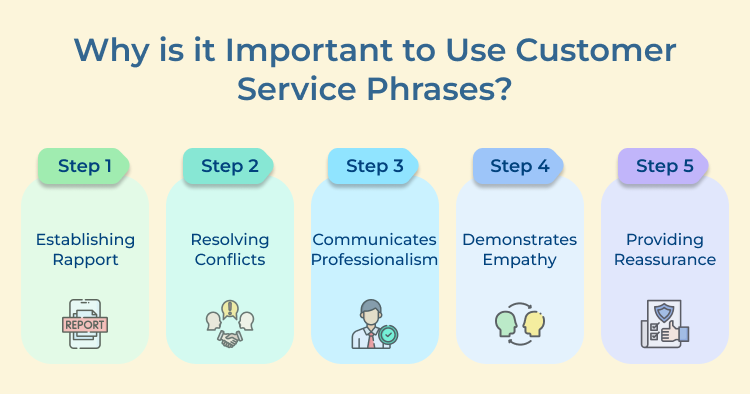
93% of the customers agree that customer’s expectations are higher than ever. When it comes to customer service, starting off a conversation on a positive note makes all the difference.

Starting a conversation with a warm greeting and a willingness to help sets a positive tone for the interaction. It shows the customer that you are ready to assist them with whatever they need. The simple greeting shows appreciation for the customer reaching out and sets the stage for a helpful conversation.
1. Shows appreciation: Thanking the customer for reaching out, it immediately sets a positive tone for the conversation.
2. Creates a welcoming atmosphere: The use of “Hello” and “How can I assist you?” demonstrates a willingness to make the customer feel valued.
3. Encourages communication: Asking how you can assist the customer, it opens the door for them to express their needs and allows you to provide the best possible assistance.
Enthusiasm and a genuine desire to help make customers feel appreciated. It shows that you are dedicated to providing exceptional service. Expressing delight in helping the customer shows genuine interest in resolving their issue or answering their questions.
1. Expresses enthusiasm: Using the word “delighted” conveys excitement to help the customer and shows that their needs are important to you.
2. Personalizes the interaction: Stating that you are delighted to assist, it adds a personal touch to the conversation and makes the customer feel special.
3. Sets a positive tone: Starting the conversation using a positive language like this helps to create a pleasant experience for the customer from the beginning.
Acknowledging the customer’s issue and assuring them that you will address it shows a commitment to solving their problem. It reassures the customer that their concerns are being taken seriously.
1. Acknowledges the issue: Thanking the customer for bringing the matter to your attention. It shows that you take their concerns seriously and are committed to finding a solution.
2. Promises action: Stating that you will work on resolving the issue, it reassures the customer that their problem is being addressed promptly.
3. Builds trust: Following through on your promise to resolve the issue demonstrates your reliability to customer satisfaction, which builds loyalty.
Showing empathy and understanding goes a long way in building rapport with customers. By acknowledging their concerns and offering to help, you portray that you are actively listening as well as focused on finding a solution. A willingness to assist reassures the customer that their issue is being taken seriously.
1. Shows empathy: Acknowledging the customer’s concern and stating that you understand demonstrates empathy as well as helps the customer feel heard.
2. Offers assistance: Stating that you will see what you can do to help shows that you are proactive in finding a solution and are committed to assisting the customer.
3. Provides reassurance: The response reassures the customer that their issue is being taken seriously, which alleviates their concerns and forges trust in your ability to help.
17% of consumers will share awareness of a bad customer service of a brand to their closed ones. Effective communication is key in customer/agent interaction. Here’s how to make an impact:
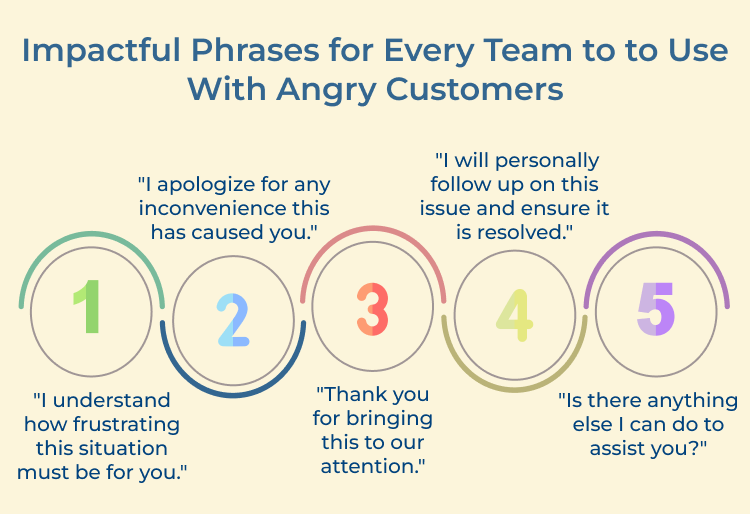
Acknowledging and empathizing with the customer’s emotions can go a long way in calming them down. Showing that you understand the customer’s perspective, you are validating their feelings while also showing that you care about their experience.
1. Empathy: Expressing empathy towards the customer’s frustration validates their feelings and shows that you care about their experience.
2. Connection: The phrase builds a connection with the customer by acknowledging their emotions and showing that you are on their side. It creates a sense of camaraderie.
3. De-escalation: Acknowledging the customer’s frustration, you de-escalate the situation and work towards finding a resolution. The phrase creates a more positive customer service experience.
Taking responsibility for the issue, even if it was not directly your fault, portrays accountability and shows the customer that you are committed to finding a resolution. Apologizing sincerely can also help to de-escalate the situation and forge trust with the customer.
1. Acknowledgment: Apologizing for any inconvenience acknowledges the customer’s feelings and shows empathy for their situation.
2. Empathy: Showing that you understand diffuses the situation and reassures the customer that you are on their side.
3. Customer retention: Apologizing for mistakes or inconveniences retains customers by showing that you are willing to take responsibility and make amends.
Thanking the customers for raising their concerns shows that you value their opinion and are committed to addressing their issues. It also helps to shift the focus from the problem to the solution, working towards a positive outcome.
1. Gratitude: Expressing gratitude for the opportunity to make things right shows appreciation for the customer’s patience.
2. Positive reinforcement: By thanking the customer for giving you the chance to rectify the situation, you reinforce positive interactions and show that you value their business.
3. Customer satisfaction: Acknowledging the customer’s willingness to allow you to fix the issue leads to increased customer satisfaction.
Assuring the customer that their issue will be taken seriously and personally addressed instills confidence in your company. By taking ownership of the problem and providing a timeline for resolution, you are demonstrating your commitment to providing excellent customer service.
1. Personal touch: When you will personally follow up on the issue, it shows the customer that their problem is important to you and that you are willing to take action to resolve it.
2. Accountability: Taking ownership of the situation while also committing to follow through shows accountability and the customer will know that you are committed to addressing their concerns.
3. Trust-building: By personally handling the issue and ensuring resolution, you build trust with the customer as well as show that their satisfaction is your top priority.
The willingness to go above and beyond to help the customer rebuilds trust as well as strengthens the customer relationship. Asking this question opens the door for further assistance. It ensures that you are dedicated to meet the customer’s needs.
1. Assistance: Offering further assistance shows that you are committed to resolving the issue completely and ensuring the customer is satisfied.
2. Open communication: Asking if there is anything else you can do encourages open communication and gives the customer the opportunity to express any additional concerns.
3. Customer-centric approach: Actively seeking ways to assist the customer further portrays a customer-centric approach and shows that their satisfaction is your top priority.
When in customer service, the more you know, the better you get to assist better. Here are some open-ended questions you can ask to learn more about their issues.
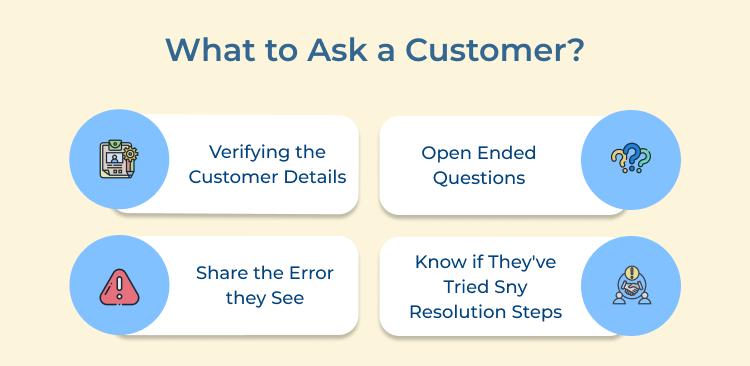
“Could you please describe the error message or issue in detail?”
The phrase clarifies the specific problem that the customer is facing. Ask for a detailed description of the error message or issue to gain a better understanding of the situation and provide more targeted assistance.
“Let me verify the information you have provided to ensure that I have all the details correct.”
It is important to confirm the accuracy of the information provided by the customer to avoid any misunderstandings or miscommunication. Verifying customer details validates that they have all the necessary information to address the issue effectively.
“I understand that you are experiencing an issue. Can you please describe the problem in more detail?”
The phrase acknowledges the customer’s concern and encourages them to provide additional information. By asking the customer to describe the problem in more detail, the customer service representative gathers relevant information that helps in diagnosing and resolving the issue promptly.
“Could you provide me with any error codes or messages that you have encountered?”
Sometimes, error codes or messages provide valuable clues about the nature of the problem. Ask the customer to provide any error codes or messages they have encountered. The customer service representative then gains insight into the technical aspects of the issue and determines the appropriate course of action.
“Have you tried any troubleshooting steps to resolve the issue?”
Inquire about any troubleshooting steps that the customer may have already taken to address the problem. Ask this question to avoid suggesting duplicate solutions and focus on finding new ways to resolve the issue effectively.
One key aspect of delivering great customer service is knowing how to effectively communicate with customers to address their needs.
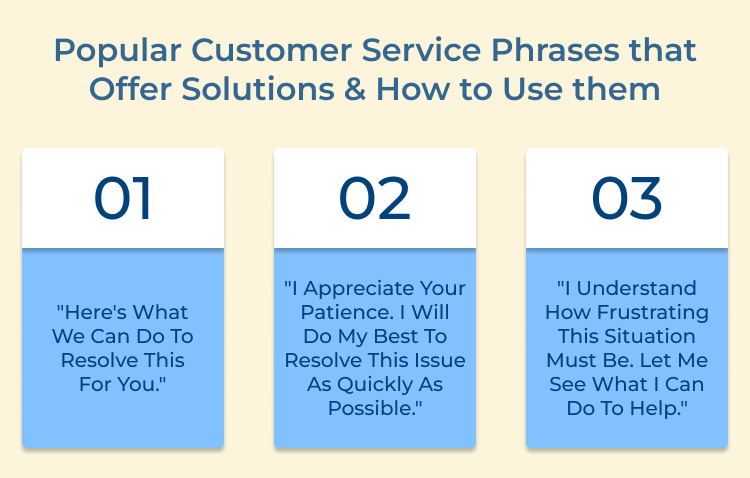
1. “Here’s what we can do to resolve this for you.”
Offering a clear and actionable solution is crucial when addressing customer issues. Use this phrase to present customers with a resolution that addresses their concerns. Be sure to explain the steps involved in the resolution process and encourage the customer to provide feedback or ask any questions they may have. Offering a concrete solution demonstrates your commitment to customer satisfaction and helps build trust with the customer.
2. “I appreciate your patience. I will do my best to resolve this issue as quickly as possible.”
Acknowledging the customer’s patience while setting realistic expectations manage customer expectations and alleviate any potential frustrations. By committing to resolving the issue promptly, the customer service representative shows a sense of urgency and dedication to providing quality service.
3. “I understand how frustrating this situation must be. Let me see what I can do to help.”
Empathizing with the customer’s emotions builds rapport and trust. Acknowledge the customer’s frustration as well as express a willingness to assist to show that you care about the customer’s experience and are committed to finding a resolution.
Ending a customer service call on a positive note maintains a good relationship with your customers.
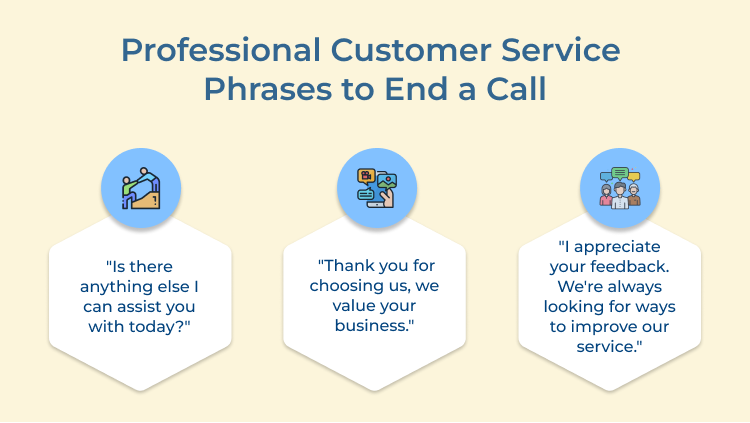
1. “Is there anything else I can assist you with today?” : The phrase shows that you are willing to assist more concern that the customer has. It also ensures that all their needs are met over one call.
2. “Thank you for choosing us, we value your business.”: Expressing gratitude and acknowledging the customer’s choice to do business with you leaves a lasting positive impression as well as shows that you value their patronage.
3. “I appreciate your feedback. We’re always looking for ways to improve our service.” : Asking for feedback and showing a willingness to improve based on the customer’s input demonstrates that you are committed to providing excellent service as well as continuously striving to meet their needs.
Customer service is the only team in the business that has effective one-on-one communication. Here are some customer service words and phrases to avoid:
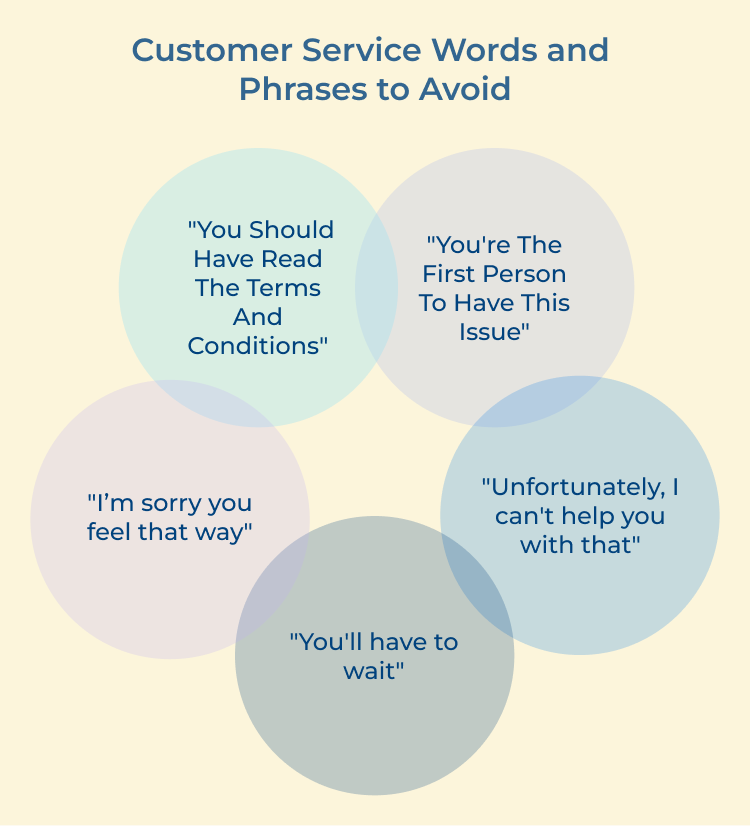
1. “You should have read the terms and conditions”
The phrase can come across as condescending while also blaming the customer for not reading the terms and conditions. Instead, try to explain the situation in a more helpful and understanding manner.
2. “You’re the first person to have this issue”
The phrase dismisses the customer’s concerns and makes them feel isolated in their problem. It’s important to acknowledge the issue and work towards finding a solution, rather than downplaying the customer’s experience.
3. “Unfortunately, I can’t help you with that”
While it’s important to be transparent about the limits of your abilities, saying this phrase without offering any alternative solutions leaves the customer feeling frustrated. Instead, try to offer other options or escalate the issue to someone who can help.
4. “You’ll have to wait”
The phrase makes customers feel like their time is not valued. Instead, provide an estimated time frame for when the issue will be resolved or offer to follow up with them once more information is available.
5. “I’m sorry you feel that way”
The phrase can come across as insincere and dismissive of the customer’s emotions. Instead, try to empathize with the customer’s frustration as well as work towards finding a resolution that satisfies both parties.
Mastering the art of customer service communication is essential for any business looking to build strong relationships with its customers. By using essential phrases, you can effectively address customer needs, resolve issues and create a positive experience. Whether it’s expressing empathy, providing solutions, or offering gratitude, the right words make a world of difference.
Remember to listen actively, communicate clearly and always go the extra mile to ensure customer satisfaction. With practice and dedication, you become a master of customer service communication as well as leave a lasting impression on everyone you interact with.
What is positive phrasing in customer service?
Positive phrasing in customer service involves using language that is upbeat, friendly and helpful. Instead of saying “I don’t know,” try saying “Let me find out for you.” Positive phrasing creates a more pleasant interaction with customers and leaves them feeling satisfied with the service they received.
How do you deal with repetitive customer service questions?
Dealing with repetitive customer service questions can be frustrating, but it’s important to remain patient and offer consistent, helpful responses. One approach is to create a FAQ page on your website or provide customers with a self-service option where they find answers to common questions. You can also train your team to handle these inquiries efficiently and with empathy.
How do you respond to an angry customer?
When faced with an angry customer, it’s important to remain calm, listen actively to their concerns and empathize with their situation. Apologize for any inconvenience they have experienced and work towards finding a solution that meets their needs. It’s essential to show empathy while understanding in these situations to de-escalate the situation and leave the customer feeling valued.
What are the 7 forbidden phrases of customer service?
The seven forbidden phrases of customer service include: “I don’t know.”, “That’s not my job.”, “You’re wrong.”, “I can’t help you with that.”, “Calm down.”, “It’s company policy.”, “You should have read the terms and conditions.” Using these phrases make customers feel unheard, frustrated and dissatisfied with the service they receive. It’s important to avoid these phrases and instead focus on providing excellent customer service.
What is an example of an excellent customer service phrase?
An example of an excellent customer service phrase is “Thank you for bringing this to our attention. We will work to resolve this issue for you as quickly as possible.” This phrase acknowledges the customer’s concern, shows appreciation for their feedback and reassures them that their issue will be addressed promptly.